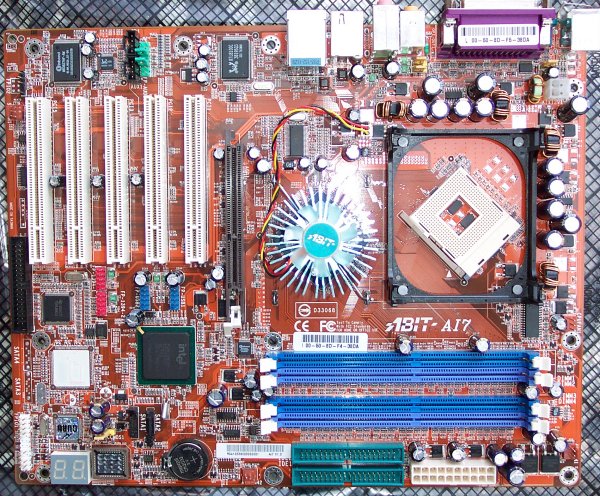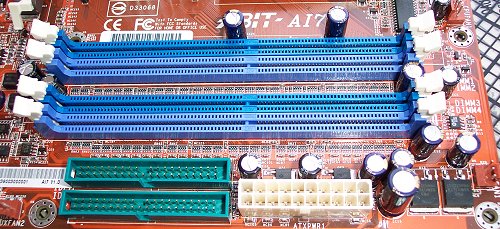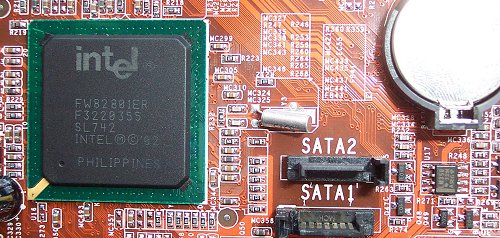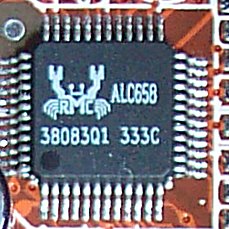Layout and features
The AI7, a name that brings a certain competitor to mind, is ABIT's way of making a board 'better' than the competition's. You can only eke out so much performance from a chipset, so other avenues have to be explored. The MAX3 Canterwood incorporated a novel motherboard cooling solution in an attempt to differentiate it from the hordes of i875P-based boards currently vying for your money.
It's a pretty busy-looking board from most angles. ABIT chooses the off-brown PCB colour that has graced, amongst others, the BH7. The AI7 is a little idiosyncratic in a few respects. Notice how the ZIF socket has been rotated 45 degrees clockwise from the usual position on most other Springdale boards. The socket lever usually points to the PCI slots and North Bridge cooler. Cooling shouldn't be compromised, though, as the CPU's heatspreader is the only contact point for the cooler. The IC7 (Canterwood) featured metal screws that fastened into the underside of the board; we only have plastic pushpins here.
Our internal research has suggested that Canterwoods and Springdale dual-channel boards are ripe for FSB overclocking. We've seen many a i865PE / i875P board pass through HEXUS labs. and almost every one has managed 250FSB with stability. Some have gone as far as 300FSB. ABIT uses a 4-phase PWM to provide stable power to the CPU, and the 4-pin 12v connector can be seen in the top-right corner. We'd have liked it closer to the 20-pin main power connector.

Speaking of which, here it is. Its location and that of the primary and secondary IDE ports is subjectively excellent. There's little worse than having to stretch PSU's wires across a motherboard. ABIT colour codes the 4 DIMM slots for easy dual-channel running, which provides up to 4GB of RAM capacity, assuming you're rich enough to afford 1GB modules. Just a small point here, but we'd prefer the IDE ports to have the insert notch the other way around. 2 of 4 usable fan headers (the North Bridge cooler takes up the fifth header) can be seen on the right. The North Bridge fan is generally quiet in use. Its speed can be manipulated via an excellent BIOS, which we'll come to in good time.

Intel, VIA and SiS have all integrated Serial ATA into their respective South Bridges. The ICH5R, as specified here, manages to run SATA in independent, RAID0 and now RAID1 formats. SATA drives still attract a price premium over their PATA counterparts, but the premium is now small enough for a first-time buyer to consider SATA as an attractive proposition. It's not really any faster than the incumbent standard, it's just neater in a number of ways. At least two SATA ports are now standard fare on most Springdale / Canterwood boards.

Just below the ICH5R are some further goodies. No chipset manufacturer has yet incorporated FireWire support on an on-chip basis. That job is left to discrete controllers, usually from either VIA or Texas Instruments, the latter being the case here. The TSB43AB23 is a single-chip 3-port FireWire controller that's been seen on ABIT boards in the past. My very own ABIT IT7-MAX features it. The white sticker in the middle is ABIT's method of illustrating that another AI7 board, perhaps the deluxe version, will carry further SATA support via a discrete controller. Our money's on Silicon Image's 2-port range. Indeed, the PCB is marked with SATA3 and SATA4 etchings, suggesting that this is the case.
Next door is ABIT's µGURU monitoring chip. much like MSI's CoreCell technology. It's a comprehensive system monitoring tool that allows the user to change a number of key parameters from an easy-to-use OS GUI. We'll have a closer look at it on the following page. ABIT's debug LED display is a welcome addition to the AI7. As usual, it runs through a number of codes when completing the initial POST sequence. Any failures manifest themselves via a static code on the LED display. Cross-check this with the manual and basic troubleshooting should help cure the problem.


We'd normally gloss over the on-board sound, often by lamenting its quality when compared to discrete, hardware cards. However, ABIT has chosen Realtek's all-new AC'97 Rev. 2.3 ALC658 6-channel CODEC for the AI7. It's really rather good. A signal-to-noise ratio of in excess of 100dB and 18-bit resolution make it a decent choice for on-board duties. It also features Rev 2.3's auto jack-sensing technology (impedence based). Comparing it directly to the older ALC650 highlighted the gains in clarity achieved by the '658. Sound quality is subjective matter, and these subjective ears reckon it's a good step in the right direction. Informal testing was undertaken with a pair of studio-class Sony CD1700 headphones.

The AI7 features 5 PCI slots, but due to the large North Bridge cooler the AGP slot has effectively been moved down the board. This results in even sleek coolers, as found on a standard 9800 PRO, partly obscuring the first slot. Even if you do manage to insert a card into the first PCI slot, you'll be heavily compromising the GPU fan's cooling ability.
It's a shame, then, that ABIT hasn't continued the good work by adding Gigabit LAN. We've seen Realtek's RTL8110S single-chip Gigabit Ethernet controller on the recent DFI i865PE INFINITY. ABIT chooses the standard 8100C 10/100 option here.

A reasonable arrangement of ports and socket, which includes both S/PDIF-In and Out, USB2.0, FireWire, and audio jacks for 5.1 sound. A decent, well-rounded package from ABIT.









